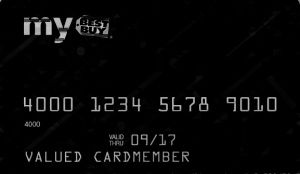【Python_Opencv图像处理框架】信用卡数字识别项目
写在前面
本篇文章是opencv学习的第六篇文章,前面主要讲解了对图像的一些基本操作,这篇文章我们就开始大展身手,将前面所学的基础操作活学活用。既能复习基础操作,又能学到一些新的知识。作为初学者,我尽己所能,但仍会存在疏漏的地方,希望各位看官不吝指正
写在中间
( 1 )简单介绍
我们通过opencv提供的一些函数,来实现基础操作,看完本篇文章,你就能轻松地将这信用卡上的数字识别出来
该技术首先通过图像处理技术,将信用卡图像转换为灰度图像,并提取出图像中的数字。然后,使用深度学习算法,建立特征提取器,对提取出的数字特征进行特征学习和识别。最后,将识别结果与预设的信用卡数字进行比对
( 2 )操作步骤
对模板
- 读取数字模板图像
cv2.imread()
-
数字模板转换为灰度图
cv2.cvtColor() -
灰度图转换为二值图
cv2.threshold(),并实现对图像的黑白反转
- 对二值图轮廓检测
cv2.findContours(),只检测外轮廓且保存对角线上的点;
- 将轮廓从左到右依次排序
contours.sort_contours(),之后遍历每一个轮廓
对目标图像
- 读取信用卡图像
cv2.imread()
- 信用卡图重构大小,并转换为灰度图
- 礼帽操作
cv2.morphologyEx()。突出明亮的部分,过滤较暗的部分
- Sobel算子边缘检测
cv2.Sobel()
- 闭操作(先膨胀再腐蚀)+二值化+闭操作
- 计算并画出轮廓
cv2.findContours()、cv2.drawContours()
- 下面的操作还有很多:遍历轮廓,筛选出数字轮廓,将数字轮廓进行排序,对四组轮廓每组都灰度处理,提取数字轮廓,将数字轮廓与模板数字轮廓比对,得出数字结果,最后绘制出来,大致效果如下:
( 3 )代码展示
# 导入工具包
from imutils import contours
import numpy as np
import argparse
import cv2
import myutils
# 设置参数
# ap = argparse.ArgumentParser()
# ap.add_argument("-i", "--image", required=True,
# help="path to input image")
# ap.add_argument("-t", "--template", required=True,
# help="path to template OCR-A image")
# args = vars(ap.parse_args())
# 指定信用卡类型
FIRST_NUMBER = {
"3": "American Express",
"4": "Visa",
"5": "MasterCard",
"6": "Discover Card"
}
# 绘图展示
def cv_show(name, img):
cv2.imshow(name, img)
cv2.waitKey(0)
cv2.destroyAllWindows()
# 轮廓排序
def sort_contours(cnts, method="left-to-right"):
reverse = False
i = 0
if method == "right-to-left" or method == "bottom-to-top":
reverse = True
if method == "top-to-bottom" or method == "bottom-to-top":
i = 1
boundingBoxes = [cv2.boundingRect(c) for c in cnts] # 用一个最小的矩形,把找到的形状包起来x,y,h,w
(cnts, boundingBoxes) = zip(*sorted(zip(cnts, boundingBoxes), key=lambda b: b[1][i], reverse=reverse))
return cnts, boundingBoxes
def resize(image, width=None, height=None, inter=cv2.INTER_AREA):
dim = None
(h, w) = image.shape[:2]
if width is None and height is None:
return image
if width is None:
r = height / float(h)
dim = (int(w * r), height)
else:
r = width / float(w)
dim = (width, int(h * r))
resized = cv2.resize(image, dim, interpolation=inter)
return resized
# 读取一个模板图像
img = cv2.imread("D:\python\Program\pythonProject\photos\P_5_0.png")
cv_show('img', img)
# cv2.imwrite("D:\python\Program\pythonProject\photos\P_5.jpg", img)
# 灰度图,颜色通道BGR to GRAY
ref = cv2.cvtColor(img, cv2.COLOR_BGR2GRAY)
cv_show('ref', ref)
# 二值图像(因为模板的边缘都是白色的)
ref = cv2.threshold(ref, 10, 255, cv2.THRESH_BINARY_INV)[1]
cv_show('ref', ref)
# cv2.imwrite("D:\python\Program\pythonProject\photos\P_6.jpg", ref)
# 计算轮廓
# cv2.findContours()函数接受的参数为二值图,即黑白的(不是灰度图),
# cv2.RETR_EXTERNAL只检测外轮廓(需要得到他的外接矩形),
# cv2.CHAIN_APPROX_SIMPLE只保留终点坐标
# 返回的list中每个元素都是图像中的一个轮廓
refCnts, hierarchy = cv2.findContours(ref.copy(), cv2.RETR_EXTERNAL, cv2.CHAIN_APPROX_SIMPLE)
cv2.drawContours(img, refCnts, -1, (0, 0, 255), 3)
cv_show('img', img)
# cv2.imwrite("D:\python\Program\pythonProject\photos\P_7.jpg", img)
# 轮廓排序
print(np.array(refCnts).shape) # 打印轮廓为 (10,)
refCnts = contours.sort_contours(refCnts, method='left-to=right')[0]
digits = {}
# 遍历每一个轮廓
for (i, c) in enumerate(refCnts):
# 计算外接矩形并且resize成合适大小
(x, y, w, h) = cv2.boundingRect(c)
roi = ref[y:y + h, x:x + w]
# resize一下合适的大小
roi = cv2.resize(roi, (57, 88))
# 每一个数字对应每一个模板
digits[i] = roi
# 初始化卷积核
rectKernel = cv2.getStructuringElement(cv2.MORPH_RECT, (9, 3))
sqKernel = cv2.getStructuringElement(cv2.MORPH_RECT, (5, 5))
# 读取输入图像,预处理
image = cv2.imread("D:\python\Program\pythonProject\photos\P_8_0.png")
cv_show('image', image)
# cv2.imwrite("D:\python\Program\pythonProject\photos\P_8.jpg", image)
image = resize(image, width=300)
gray = cv2.cvtColor(image, cv2.COLOR_BGR2GRAY)
cv_show('gray', gray)
# cv2.imwrite("D:\python\Program\pythonProject\photos\P_9.jpg", gray)
# 礼帽操作,突出更明亮的区域
tophat = cv2.morphologyEx(gray, cv2.MORPH_TOPHAT, rectKernel)
cv_show('tophat', tophat)
# cv2.imwrite("D:\python\Program\pythonProject\photos\P_10.jpg", tophat)
# 梯度计算:根据字体的大小进行过滤
gradX = cv2.Sobel(tophat, ddepth=cv2.CV_32F, dx=1, dy=0, ksize=-1) # ksize=-1相当于用3*3的
gradX = np.absolute(gradX)
(minVal, maxVal) = (np.min(gradX), np.max(gradX))
gradX = (255 * ((gradX - minVal) / (maxVal - minVal)))
gradX = gradX.astype("uint8")
print(np.array(gradX).shape)
cv_show('gradX', gradX)
# cv2.imwrite("D:\python\Program\pythonProject\photos\P_11.jpg", gradX)
# 通过闭操作(先膨胀,再腐蚀)将数字连在一起
gradX = cv2.morphologyEx(gradX, cv2.MORPH_CLOSE, rectKernel)
cv_show('gradX', gradX)
# cv2.imwrite("D:\python\Program\pythonProject\photos\P_12.jpg", gradX)
# THRESH_OTSU会【自动】寻找合适的阈值,适合双峰,需把阈值参数设置为0
thresh = cv2.threshold(gradX, 0, 255, cv2.THRESH_BINARY | cv2.THRESH_OTSU)[1]
cv_show('thresh', thresh)
# cv2.imwrite("D:\python\Program\pythonProject\photos\P_13.jpg", thresh)
# 再来一个闭操作
thresh = cv2.morphologyEx(thresh, cv2.MORPH_CLOSE, sqKernel) # 再来一个闭操作
cv_show('thresh', thresh)
# cv2.imwrite("D:\python\Program\pythonProject\photos\P_14.jpg", thresh)
# 计算轮廓
threshCnts, hierarchy = cv2.findContours(thresh.copy(), cv2.RETR_EXTERNAL, cv2.CHAIN_APPROX_SIMPLE)
cnts = threshCnts
cur_img = image.copy()
cv2.drawContours(cur_img, cnts, -1, (0, 0, 255), 3)
cv_show('img', cur_img)
locs = []
cv2.imwrite("D:\python\Program\pythonProject\photos\P_16.jpg", cur_img)
# 遍历轮廓
for (i, c) in enumerate(cnts):
# 计算矩形
(x, y, w, h) = cv2.boundingRect(c)
ar = w / float(h)
# 选择合适的区域,根据实际任务来,这里的基本都是四个数字一组
if ar > 2.5 and ar < 4.0:
if (w > 40 and w < 55) and (h > 10 and h < 20):
# 符合的留下来
locs.append((x, y, w, h))
# 将符合的轮廓从左到右排序
locs = sorted(locs, key=lambda x: x[0])
output = []
# 遍历每一个轮廓中的数字
for (i, (gX, gY, gW, gH)) in enumerate(locs):
# initialize the list of group digits
groupOutput = []
# 根据坐标提取每一个组
group = gray[gY - 5:gY + gH + 5, gX - 5:gX + gW + 5]
cv_show('group', group)
# 预处理
group = cv2.threshold(group, 0, 255, cv2.THRESH_BINARY | cv2.THRESH_OTSU)[1]
cv_show('group', group)
# 计算每一组的轮廓
digitCnts, hierarchy = cv2.findContours(group.copy(), cv2.RETR_EXTERNAL, cv2.CHAIN_APPROX_SIMPLE)
digitCnts = contours.sort_contours(digitCnts, method="left-to-right")[0]
# 计算每一组中的每一个数值
for c in digitCnts:
# 找到当前数值的轮廓,resize成合适的的大小
(x, y, w, h) = cv2.boundingRect(c)
roi = group[y:y + h, x:x + w]
roi = cv2.resize(roi, (57, 88))
cv_show('roi', roi)
# 计算匹配得分
scores = []
# 在模板中计算每一个得分
for (digit, digitROI) in digits.items():
# 模板匹配
result = cv2.matchTemplate(roi, digitROI, cv2.TM_CCOEFF)
(_, score, _, _) = cv2.minMaxLoc(result)
scores.append(score)
# 得到最合适的数字
groupOutput.append(str(np.argmax(scores)))
# 画出来
cv2.rectangle(image, (gX - 5, gY - 5), (gX + gW + 5, gY + gH + 5), (0, 0, 255), 1)
cv2.putText(image, "".join(groupOutput), (gX, gY - 15), cv2.FONT_HERSHEY_SIMPLEX, 0.65, (0, 0, 255), 2)
# 得到结果
output.extend(groupOutput)
print("Credit Card Type: {}".format(FIRST_NUMBER[output[0]]))
print("Credit Card #: {}".format("".join(output)))
cv2.imshow("Image", image)
# cv2.imwrite("D:\python\Program\pythonProject\photos\P_17.jpg", image)
cv2.waitKey(0)
cv2.destroyAllWindows()
写在最后
点赞,你的认可是我创作的动力!
⭐ 收藏,你的青睐是我努力的方向!
✏️ 评论,你的意见是我进步的财富!









